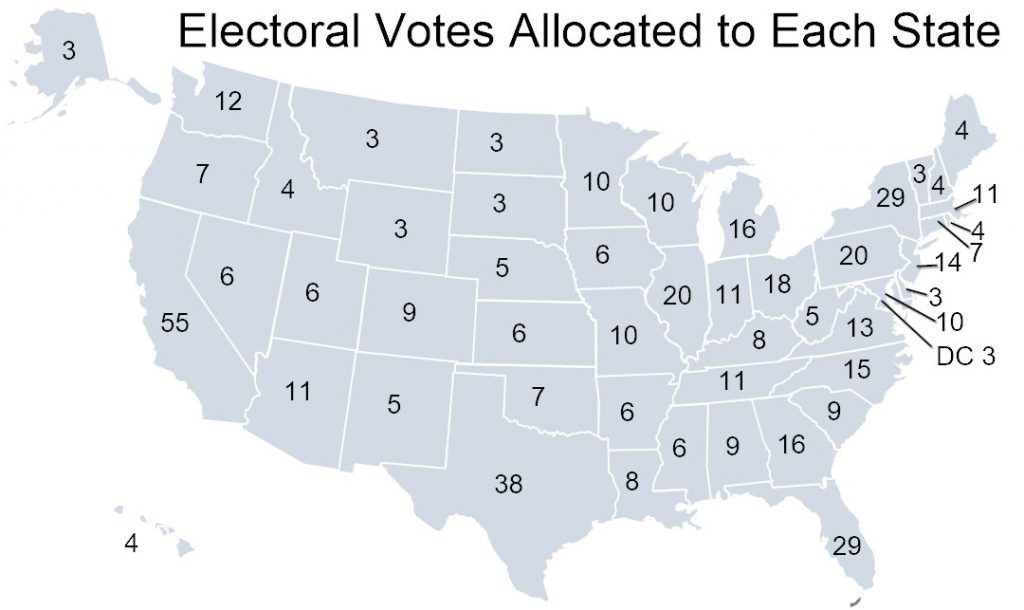November 30, 2020
The Electoral College in 2020 is part of ESPC’s How Does the Process Work? Series
We wrote about the election, your ballot, and the process of casting that ballot in our “Unpacking Your Ballot” series pre-election. But there is just as much to talk about post-election.
Lately, there has been a *lot* of talk about the Electoral College. We want to make sure you understand what it means and how it works, so we’re answering some of the most common questions we’ve heard.
Q: First, what actually happens when I cast my vote for President on election day?
A: Election Day—November 3, 2020—is the day voters in each state selected their presidential electors. Electors’ names are not on the ballot in most states. Instead, when a voter casts a vote for a presidential candidate, s/he is also casting a vote for the electors already selected by that candidate’s party. If the majority of voters in a state vote for the Republican candidate for president, the Republican slate of electors is elected. If a majority vote for the Democratic candidate, the Democratic slate of electors is chosen.
Q: How many electoral college votes does each state have?
The number of electoral college votes in each state is based on population (as determined by the U.S. Census), and equals the number of U.S. senators and representatives of that state: two votes for its two senators, plus an additional number of votes equal to the number of its Congressional districts. Just as Wyoming has two senators and one congressperson, Wyoming also has three electoral votes.

Q: What’s the process and timeline for settling any election disputes?
A: All state recounts and court contests over presidential election results must be completed by December 8, 2020 (3 U.S.C. § 5). For detailed information on state post-election processes, there’s a full explanation on this NCSL page.
Q: What are the key dates for the electoral college? (With thanks to the National Conference of State Legislatures for this comprehensive overview.)
A: Dec. 14, 2020: Meeting of the Electors. The electors meet in each state and cast their ballots for president and vice president. Each elector votes on his or her own ballot and signs it. The ballots are immediately transmitted to various people: one copy goes to the president of the U.S. Senate (who is also the vice president of the United States); this is the copy that will be officially counted later. Other copies go to the state’s secretary of state, the National Archives and Records Administration, and the presiding judge in the district where the electors meet (this serves as a backup copy that would replace the official copy sent to the president of the Senate if it is lost or destroyed).
Dec. 23, 2020: Deadline for Receipt of Ballots. The electors’ ballots from all states must be received by the president of the Senate by this date. There is no penalty for missing this deadline.
Jan. 6, 2021: Counting of the Electoral Ballots. The U.S. Congress meets in joint session to count the electoral votes.
Jan. 20, 2021: Inauguration Day. The president-elect becomes the president of the United States.
Want to know about the nomination of electors and the awarding of electoral college votes? Click here!
Heard of “faithless electors” and want to know what they are, what the Supreme Court of the US has to say about them, and how the Wyoming Statute deals with them? Click here!
Curious about the canvassing and ballot certification process that happens post-election day? Click here!
Wondering where the Electoral College came from—and why we still have it? Here are three good places to start.



 Support: Supporting this resolution aligns with our commitment to fair elections by ensuring that the voices of everyday citizens are not drowned out by unlimited spending from wealthy special interests. The rising costs of campaigns, reflected in ESPC’s recent campaign finance reports, make it harder for ordinary people to run for office and for voters to have an equal say with their dollar power. Agree?
Support: Supporting this resolution aligns with our commitment to fair elections by ensuring that the voices of everyday citizens are not drowned out by unlimited spending from wealthy special interests. The rising costs of campaigns, reflected in ESPC’s recent campaign finance reports, make it harder for ordinary people to run for office and for voters to have an equal say with their dollar power. Agree?  Concerns: Masquerading as a transparency bill, this bill shoves together many components of other bills we oppose. Despite the lack of evidence that we have an issue with voter fraud in our state, this bill imposes unnecessary barriers and opens our processes up to errors.
Concerns: Masquerading as a transparency bill, this bill shoves together many components of other bills we oppose. Despite the lack of evidence that we have an issue with voter fraud in our state, this bill imposes unnecessary barriers and opens our processes up to errors. ESPC Concerns: This bill creates a $2 million fund for runoff election costs and increases candidate spending. We agree with the intent of this bill, however, we believe in saving money and increasing voter turnout. We think a bill like this should be implemented in a single election, with the top two vote-getters facing off in the General.
ESPC Concerns: This bill creates a $2 million fund for runoff election costs and increases candidate spending. We agree with the intent of this bill, however, we believe in saving money and increasing voter turnout. We think a bill like this should be implemented in a single election, with the top two vote-getters facing off in the General. Support:
Support:  Concerns:
Concerns:  Concerns:
Concerns:  Concerns: Hand-counting is expensive, people-intensive, time-intensive, and inaccurate. The Equality State Policy Center has laid out the reasons to keep our ballot machines, which are accurate, timely, and well-tested.
Concerns: Hand-counting is expensive, people-intensive, time-intensive, and inaccurate. The Equality State Policy Center has laid out the reasons to keep our ballot machines, which are accurate, timely, and well-tested. Concerns:
Concerns:  Support:
Support:  Concerns:
Concerns:  Support:
Support:  Concerns:
Concerns:  Support:
Support: 









